Welcome. This is where things go that don’t fit in…
Welcome.
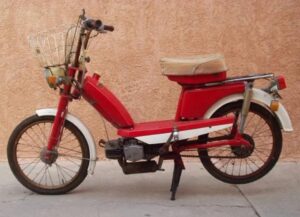
1987 Kamasura Emei 500 (or 50D?)
Here is info about this Kamasura | Moped Wiki — Moped Army
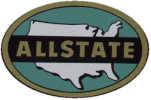 ’56-64
’56-64  ’65-67
’65-67 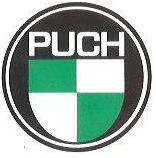
Sears stores sold the Allstate line of motorcycles from 1954 to 1968. The Allstate Mo-Ped and motorcycles were made by Puch. Allstate scooters were made by Cushman and Piaggio. There were also Allstate insurance, automobiles, tires, auto parts and accessories, garage door openers, fire extinguishers, and other products with that name.
Allstate: The name Allstate came from a contest held by Sears in 1925. From http://www.searsarchives.com/brands/allstate.htm, “The Allstate brand began in 1925 as part of a national contest to name Sears’ new brand of automobile tires. Public response in the contest was overwhelming. Before it was over, 937,886 people submitted a total of 2,253,746 names. Entries came from every state and in 25 different languages. Hans Simonson of Bismarck, N.D., received a $5,000 cash prize for his winning entry Allstate.”
Motor West: Some Sears Allstate Mo-Ped (and early Puch or Tomos compatibles) parts can be found at Motor West Motorcycles in Milwaukee Wisconsin USA: http://motorwestmotorcycles.com/.
Sears Allstate Riders: A full list of all Sears Allstate models is at Models/Sears Allstate Riders. Every Sears model number listed below has a link a Sears Allstate Riders web page for that model, with photos, flyers and info.
Headlight: The headlight can help with identification. All ’56 to ’62 and some ’63-66 had a 6 volt 15/15 watt headlight. Most ’63-66 models had a 6V 25/25 watt headlight. The 25/25 bulb, glass and chrome ring were bigger than the 15/15 bulb, glass and chrome ring.
Switch: On mopeds, ’56 to ’63 had the headlight switch on the top of the headlight. ’65-66 had the headlight switch on the handlebar. ’64 models had it either way.

Magneto: Besides making the ignition spark, the magneto makes power for the lights. There is no battery or voltage regulator. To regulate the voltage, the magneto watts has to nearly match the headlight and tail light bulbs watts. Models with small headlights have 17 watt lights coils, 15 for headlight plus 2 for tail light. Models with big headlights have 29 watt lights coils, 25 for headlight plus 3 for tail light plus 1 for speedo light. So seeing the headlight from a distance or in a photo helps identify the magneto.
Tail light: The tail light can help with identification. Like with the headlight, the brake light bulb watts must match the brake light generator coil watts. So seeing the rear light from a distance or in a photo helps identify the magneto.
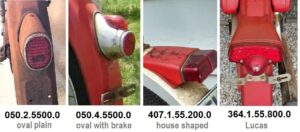
050.2.5500.0 6V 2.4w bulb oval plain
is on ’56-57 Mo-Ped
050.4.5500.0 6V 2.4w and 6V 2.4w oval with brake
’57-63 Mo-Ped, ’64 Economy Mo-Ped 810.94011,
’64-65 Mo-Ped 810.94038, 810.94040
407.1.55.200.0 6V 18/3w bulb house shaped
’60-63 Sport 60 810.94060, 810.94069,
’61-63 Compact 810.94380, 83, 90
364.1.55.800.0 6V 18/3w bulb Lucas
’63 Economy Mo-Ped 810.94018, ’64-65 Mo-Ped 810.94049,
’63-64 Sport 60 810.94061, 810.94068, ’64-66 Campus 50,
’64-66 Cheyenne, ’64-66 Compact, ’65-67 Sabre
Engines for 50cc mopeds have limited speed and power, according to what country they are sold in. They have 12mm carburetors and 2 or 3 speed manual transmissions.
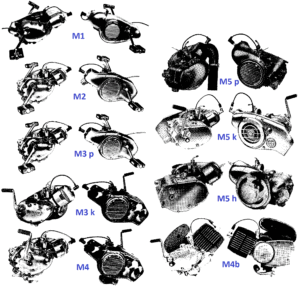
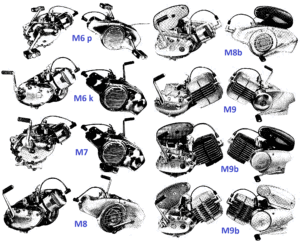
1. 1954-77 Puch M-series 2-speed moped engines M1 to M5
2. 1959-82 Puch M-series 3-speed moped engines M6 to M9
Engines for 50 to 60cc motorcycles and scooters have no limits on speed and power. They have larger ports, pipes and carburetors, and can have any number of transmission speeds.
Sears sold mopeds, motorcycles and scooters with both limited and unlimited 50-60cc engines.
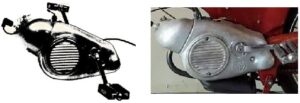


M1 50cc 2-speed with pedals hand-shift
050 ’56-57 Allstate Mo-Ped = MS50
050 ’63-64 Economy Mo-Ped (hard tail)
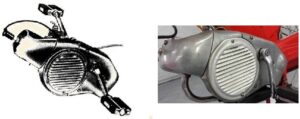
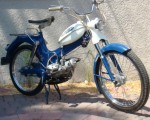
M3 50cc 2-speed with pedals hand-shift
302 ’58-65 Allstate Mo-Ped = MS50V
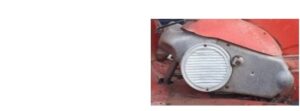
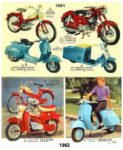
DS 60cc 3-speed kick-start hand-shift
364 ’61-66 Allstate Compact = DS50
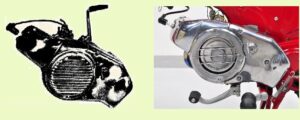

M6 50cc 3-speed kick-start foot-shift
360 ’64-66 Sears Campus 50 = MS50VDKF
Some have a solo seat and some have a long seat.

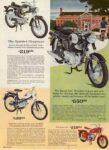
SM 60cc 3-speed kick-start foot-shift
361 ’60-64 Allstate Sport 60 = SM60
368 ’64-66 Sears Cheyenne = SM60
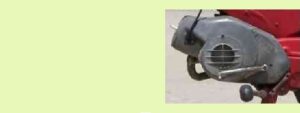
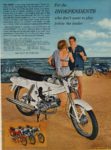
VZM 50cc 4-speed kick-start foot-shift
367 ’65-67 Sears Sabre = VZ50M
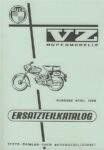
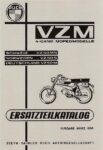
1. 1965 Puch VZ50 Parts Catalog shows a VZ engine. It covers models VZ 50 PH, PHN, PX, PXN, KH, KHN, KX, KXN, RPH; VZ 50/60 RKH, RKX; VZ 50 RPHN, RKHN, RKXN. The 4-speed VZ engine looks the same as a 3-speed M8b.
2. 1966 Puch VZ50M Parts Catalog shows VZM engine. It covers models VZ50M (Germany), VZ50S (Switzerland), VZ50MN (Norway). The 4-speed VZM engine has a different fan cover and air intake.
Six Sears Allstate 50-60cc models have 19 parts catalogs, here combined into 6. Each parts catalog is for one or more ID numbers. The ID numbers link to the parts catalog cover image on searsallstateriders.com.
Part numbers are black for exact replacement, or dark orange for a good substitute.
Prices are green for new, or dark green for good used.

Parts catalog 6 for ’56 Mo-Ped, sections 1 to 10
3 Allstate Mo-Ped Parts Catalogs combined
6 is ’56-56 for Mo-Ped 810.94000
7 is ’57-58 for Mo-Ped 810.94001
3 is ’63-64 for Econo Mo-Ped 810.94011 and 810.94018
M1 engine, 50cc 2-speed hand-shift with pedals
673 fig 00.00.000.0/00 price eng M1 engine
111 1-00 050.5.1000.0 0 none M1 engine (MS50)
444 1-05 050.5.1078.00 $4.00 M1 cylinder stud 6 x 105, orig = 103
111 1-07 050.1.1032.0 0 none M1 engine case set
111 2-32 050.1.1068 00 none M1 blower louvre cover 5.5″
111 3-16 050.5.1005.2 0 none M1 cylinder bare
111 3-16 050.5.1005.0 0 none M1 cylinder and piston assy
100 3-22 23733 00000 $4.00 M1 spark plug NGK B7HS or BR7HS
011 3-22 60410 00000 $5.00 M1 spark plug NGK BR6HS
222 4-02 050.1.1060.0 0 $11.0 M1 piston ring 38 x 2.5 GN
111 4-03 050.1.1006.2 0 none M1 piston bare 38 x 10-18-19
111 4-03 050.1.1006.0 0 none M1 piston 38 x 10-18-19, 2.5 rings
111 4-03 050.1.1006.0 0 $55.0 M1 piston 38 x 10-18-19, 2.0 rings
222 4-04 900.4714 000 $1.00 M1 piston clip 10
111 4-05 050.1.1011.0 0 $10.0 M1 piston pin 10 x 32
222 4-11 050.1079.000 none M1 L/R crank seal 17-35-8
222 4-11 900.3807 000 $7.50 M1 L/R crank seal 17-35-7
222 4-12 900.6007 000 $32.0 M1 L/R crank bearing L17
111 4-14 050.1015.0 00 none M1 crankshaft, flywheel key grove
111 6-12 050.1316 000 none M1 sprocket 11 teeth
333 22-09 27458 000.0 none M1 stator screw M4x15-slot
333 22-09 27458 000.0 $0.80 M1 stator screw M4x16-phil-wide
111 22-19 23340 0000 $1.50 M1 flywheel key #M86 3 x 5
111 22-21 900.2011 00 M1 flywheel nut M10-1.0 x 8 hex17
673 fig 050.1.1500.2/5 price M1 carburetor see Bing Allstate
111 050.1.1500.2/58 0 none carburetor ∅12 jet 58, cable choke
673 000.0.0.0000.0 price magneto 17w for 810.94000
100 050.5000.0 00 none M1 magneto 1-wire (lights) int. spark
100 900.0790 000 none M1 flywheel LM/UR1/115/17 L5 17 watt
100 900.0792 000 none M1 points base
100 900.0793 000 none M1 points lever
100 900.0796 000 none M1 lights coil 17 watt
100 900.0791 000 none M1 ignition spark coil
673 000.0.0.0000.0 price magneto 17/5w for 810.94001
010 302.2.50.000.0 none M3 magneto 3-wire int. spark =0212 125 001
010 302.2.50.010.2 none M3 flywheel LM/URC1/116/27/5 L1
010 302.2.50.015.0 $14.0 M3 points set #M19a
010 302.2.50.013.2 none M3 condenser
010 360.2.50.012.2 none M3 ignition spark coil
010 302.2.50.011.2 none M3 lights coil 17 watt
010 302.2.50.014.2 none M3 brake coil 5 watt
010 302.2.50.009.1 none M3 base plate
673 000.0.0.0000.0 price magneto 17/3?w for 810.94011
001 000.0.00.000.0 none M1+ magneto 3-wire ext. spark
001 000.0.00.000.0 none M1+ flywheel LM/URP1/115/27L1
673 000.0.0.0000.0 price magneto 29/18w for 810.94018
001 364.1.50.600.0 none DS magneto 4-wire ext. spark
001 364.1.50.610.2 none DS flywheel LM/URP1/116/29/18L1
001 302.2.50.015.0 $14.0 M3 points M19a original note 1
001 302.3.50.015.0 $16.0 M3 points M19 replacement note 2
001 500.2.50.013.2 none DS condenser
001 364.1.50.612.2 none DS ignition source coil
001 364.1.50.611.2 none DS lights coil 29 watt
001 364.1.50.614.2 none DS brake coil 18 watt
Note 1. Original 3-piece M19a points do not have a pivot post. They do not replace M19, because they require the original pivot post.
Note 2. Replacement 1-piece M19 points have a built-in pivot post. They replace M19a, after the original pivot post is unscrewed and removed from the stator base plate.
673 000.0.0.0000.0 price lights for 810.94000
100 050.2.5500.0 none tail light ‘oval plain’ no brake light
111 901.0721 000 $2.00 tail light bulb 6V 3w, orig = 2.4w
111 900.0721 000 none head light bulb 6V 15/15w
673 000.0.0.0000.0 price lights for 810.94001 and 810.94011
011 050.4.5500.0 none tail light ‘oval with brake’
111 901.0721 000 $2.00 tail light bulb 6V 3w, orig = 2.4w
011 170.5548 000 $2.00 brake light bulb 6V 3w
111 900.0721 000 none head light bulb 6V 15/15w
673 000.0.0.0000.0 price lights for 810.94018
001 364.1.55.800.0 none tail light Lucas
001 902.0709 000 none tail light bulb 6V 18/3w Ba15d
001 902.0709 000 $2.50 tail light bulb 6V 15/3w Ba15d
001 364.1.53.812.1 $7.00 headlight bulb 6V 25/25 Ba20d
673 x=18 y=36 000 price front wheel
xxx 050.2.4030 00 none spoke 204 x 2.5 left
xxx 050.2.4031 00 none spoke 196 x 2.5 right (brake)
yyy 600.4007 000 none spoke nipple 48 tpi
111 050.4015.0 00 none brake shoe set 90 x 20 EBC970
111 900.0841 000 $40.0 tire 2.25-19 (23 x 2.25) Mitas M02
111 900.0841 000 none tire 2.25-19 (23 x 2.25) Vee Rubber 013
111 900.0841 000 $42.0 tire 2.25-19 (23 x 2.25) Heidenau M3
111 900.0843 000 $12.0 inner tube 2.25-19
222 900.6200 000 $6.00 bearing 10 x 30 x 9 #6200
111 050.1.4023 00 $12.0 center spacer tube 10 x 37
673 x=18 y=36 000 price rear wheel
xxx 050.2.4030 00 none spoke 204 x 2.5 left
xxx 050.2.4031 00 none spoke 196 x 2.5 right (brake)
yyy 600.4007 000 none spoke nipple 48 tpi
111 050.4015.0 00 none brake shoe set 90 x 20 EBC970
111 900.0841 000 $40.0 tire 2.25-19 (23 x 2.25) Mitas M02
111 900.0841 000 none tire 2.25-19 (23 x 2.25) Vee Rubber 013
111 900.0841 000 $42.0 tire 2.25-19 (23 x 2.25) Heidenau M3
111 900.0843 000 $12.0 inner tube 2.25-19
222 900.6200 000 $6.00 bearing 10 x 30 x 9 #6200
111 050.1.4123 00 $13.0 center spacer tube 10 x 80
111 050.1.4109 00 none rear sprocket 34 teeth
111 050.4.2810.0 0 $20.0 chain 1/2 x 3/16″ 415H 94 links

Parts catalog 8 for ’58-61 Mo-Ped, sections 1 to 10
4 Allstate Mo-Ped Parts Catalogs combined
8 is 58-61 for 810.94010 and 810.94019
9 is 59-61 for 810.94020
2 is 62-63 for 810.94030 and 810.94039
4 is 64-65 for 810.94040 and 810.94049
M3 engine, 50cc 2-speed hand-shift with pedals
8924 fig 0000.0.00.000.0 price eng M3 engine
1111 1-00 302.6.10.000.0 none M3 engine (MS50V)
4444 1-05 050.5.1078 .0 $4.00 M1 cylinder stud 6×105 orig 103
1111 1-07 050.1.1032.0 none M1 engine case set
1111 2-32 050.10.1068 0 none M3 blower louvre cover 6.5″
1111 3-16 050.10.1005.2 none M1 cylinder bare
1111 3-16 52.1.1005.0 00 none M3 cylinder & piston
1111 3-22 60410 00 000 $5.00 M3 spark plug NGK BR6HS
2222 4-02 302.1.10.060.1 $9.00 M3 piston ring 38 x 2.0 GN
1111 4-03 364.1.10.506.0 $55.0 M6 piston assy 38 x 10-18-19
2222 4-04 900.4714 000 $1.00 M1 piston clip 10
1111 4-05 050.1.1011.0 $10.0 M1 piston pin 10 x 32
2222 4-11 900.3807 000 $7.50 M1 L/R crank seal 17-35-7
2222 4-12 900.6007 000 $32.0 M1 L/R crank bearing L17
1111 4-14 302.1.10.015.0 none M3 crankshaft, flywheel pin hole
1111 6-12 050.1317 000 none M3 sprocket 12 teeth
3333 22-09 27458 000.0 none M1 stator screw M4x15-slot
3333 22-09 27458 000.0 $0.80 M1 stator screw M4x16-phil-wide
1111 22-19 28776 00 00 none M3 flywheel key ∅3 x 5 roller
1111 22-19 28776 00 00 $4.00 M3 flywheel key ∅3 x 4 roller
1111 22-21 900.2011 00 M1 flywheel nut M10-1 x 8 hex17
8924 fig 00.00.000.0/00 price M3 carburetor see Bing Allstate
1111 364.1.15.001.0/62 none M3 carburetor ∅12 jet 62, cable choke
Changes: The M3 carburetor had a much bigger jet, 62 instead of 58, because the intake silencer (air box) was removed. A tickler (primer) was added to the float top. The choke cable pinch bolt was eliminated, so the choke cable changed from single-ended to double-ended.
8924 000.0.00.000.0 magneto 17/5w 810.94010, 19, 20, 30, 40
1111 302.2.50.000.0 none M3 Bosch magneto =0212 125 001
1111 302.2.50.010.2 none M3 flywheel LM/URC1/116/27/5 L1
1111 302.2.50.015.0 $14.0 M3 points M19a original note 1
1111 302.3.50.015.0 $16.0 M3 points M19 replacement note 2
1111 302.2.50.011.2 none M3 lights coil 17 watt
1111 302.2.50.014.2 none M3 brake light coil 5 watt
8924 000.0.00.000.0 magneto 29/18w 810.94039, 49
0011 364.1.50.600.0 none DS Bosch magneto 4-wire
0011 364.1.50.610.2 none DS flywheel LM/URP1/116/29/18L1
0011 302.2.50.015.0 $14.0 M3 points M19a original note 1
0011 302.3.50.015.0 $16.0 M3 points M19 replacement note 2
0011 500.2.50.013.2 none DS condenser
0011 364.1.50.612.2 none DS ignition source coil
0011 364.1.50.611.2 none DS lights coil 29 watt
0011 364.1.50.614.2 none DS brake coil 18 watt
Note 1. Original 3-piece M19a points do not have a pivot post. They do not replace M19, because they require the original pivot post.
Note 2. Replacement 1-piece M19 points have a built-in pivot post. They replace M19a, after the original pivot post is unscrewed and removed from the stator base plate.
8924 000.0.00.000.0 price lights for 810.94010, 11, 30, 40
1111 050.4.5500.0 none tail light ‘oval with brake’
1111 901.0721 000 $2.00 tail light bulb 6V 3w, orig = 2.4w
1111 170.5548 000 $2.00 brake light bulb 6V 3w
1111 900.0721 000 none head light bulb 6V 15/15w
8924 000.0.00.000.0 price lights for 810.94039, 49
1111 364.1.55.800.0 none tail light Lucas
1111 902.0709 000 none tail light bulb 6V 18/3w Ba15d
1111 902.0709 000 $2.50 tail light bulb 6V 15/3w Ba15d
1111 364.1.53.812.1 $7.00 headlight bulb 6V 25/25 Ba20d
1 Sears Campus 50 Parts Catalog
1964 for Campus 50 810.94090 and 810.94099
M6 engine, 50cc 3-speed hand-shift kick start
000.0.00.000.0 price M6 engine 360
050.10.1068 0 none M3 magneto cover
000.0.00.000.0/00 price M6 carburetor see Bing Allstate
360.1.15.500.0/62 none M6 carburetor ∅12 jet 62, lever choke
Changes: The M6 carb is an M3 carb with a lever operated choke instead of a cable choke.
000.0.00.000.0 price lights for 810.94090
364.1.55.800.0 none tail light Lucas
900.0721 000 none head light bulb 6V 15/15w
000.0.00.000.0 price lights for 810.94099
364.1.55.800.0 none tail light Lucas
902.0709 000 none tail light bulb 6V 18/3w Ba15d
902.0709 000 $2.50 tail light bulb 6V 15/3w Ba15d
364.1.53.812.1 $7.00 headlight bulb 6V 25/25 Ba20d
6 Allstate Compact Parts Catalogs
1 is ’61-63 for 810.94380, 810.94381, 810.94382
4 is ’64-66 for 810.94383, 810.94390, 810.94430
DS60 engine, 60cc 3-speed hand-shift kick start
14 fig 1-9 0.0.00.000.0 price eng DS60 engine 361, 364
11 1-00 000.0.00.000.0 none DS engine (DS60)
11 1-07 000.0.00.000.0 none DS engine case set
11 3-07 000.0.00.000.0 none DS cylinder bare ∅42
11 3-07 000.0.00.000.0 none DS cylinder and piston
22 4-02 000 175.1060 none DS piston ring ∅42 x 2.5 GN
11 4-03 00 56.1.1006.0 none DS piston assy ∅42
11 4-05 000 56.1.1011 none DS wrist pin ∅10 x 36
11 4-14 362.1.10.015.0 none DS crankshaft
14 000.0.00.000.0/00 price carburetor see Bing Magnum X
11 361.1.15.000.0?/?? none carb ∅17 jet ?? Bing 1/17/??
14 000.0.00.000.0 price lights 1961-63
10 407.1.55.200.0 none tail light house-shaped
11 902.0709 000 none tail light bulb 6V 18/3w Ba15d
11 902.0709 000 $2.50 tail light bulb 6V 15/3w Ba15d
11 364.1.53.812.1 $7.00 headlight bulb 6V 25/25 Ba20d
14 000.0.00.000.0 price lights 1964-66
01 364.1.55.800.0 none tail light Lucas
11 902.0709 000 none tail light bulb 6V 18/3w Ba15d
11 902.0709 000 $2.50 tail light bulb 6V 15/3w Ba15d
11 364.1.53.812.1 $7.00 headlight bulb 6V 25/25 Ba20d
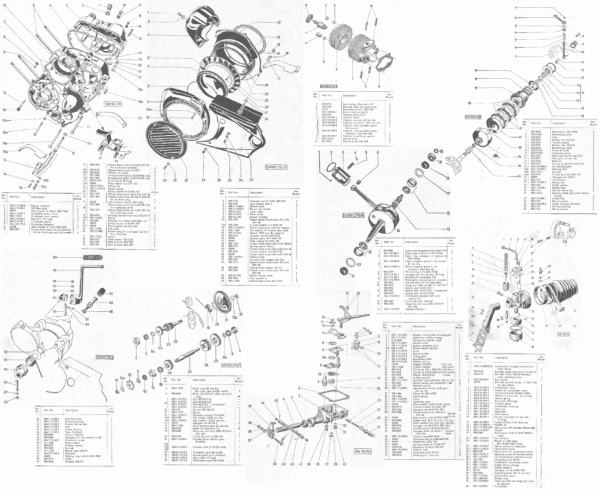
Parts catalog 3 for ’60-63 Sport 50, sections 1 to 10
3 Sport 60 and Cheyenne Parts Catalogs combined
3 is 1963 for Sport 60 810.94060 and 810.94069
4 is 1964 for Sport 60 810.94061 and 810.94068
5 is 1965 for Cheyenne 810.89520-29, 810.94070-79
SM engine, 60cc 3-speed foot-shift kick start
345 fig 1-9 0.0.00.000.00 price eng SM engine 361, 368
111 1-00 368.1.10.200.0 none SM engine (SM60)
111 1-07 364.2.10.732.0 none DS engine case set
110 2-28 050.10.1068 0 none M3 blower louvre cover 6.5″
001 2-28 368.1.10.068.1 none SM blower cover Cheyenne
111 3-01 902.0727 000 $4.00 spark plug NGK B7HS or BR7HS
111 3-07 364.1.10.605.2 none DS cylinder bare ∅42
111 3-07 364.1.10.605.0 none DS cylinder and piston
222 4-02 364.1.10.460.1 $10.0 DS piston ring ∅42 x 2.0 GN
111 4-03 364.1.10.606.0 none DS piston assy ∅42
110 4-05 364.1.10.611.1 none DS wrist pin ∅15 x 33
001 4-05 364.1.10.611.2 none DS wrist pin ∅15 x 33
111 4-14 364.1.10.615.0 none DS crankshaft
111 23-21 900.2011 00 M3 flywheel nut M10-1.0 x 8 hex17
111 23-21 28776 00 00 $4.00 M3 flywheel key ∅3×4 roller, orig 3×5
345 fig 10 000.000.0000 carburetor see Bing Magnum X
110 361.1.15.000.0/90 none carb ∅17 jet 90 Bing 1/17/54
001 368.2.15.200.0/80 none carb ∅17 jet 80 Bing 1/17/??
345 000.0.00.000.0 price magneto 29/18w
111 364.1.50.600.0 none DS Bosch magneto 4-wire
111 364.1.50.610.2 none DS flywheel LM/URP1/116/29/18L1
111 000.0000 000 $14.0 M3 points #M19a
345 000.0.00.000.0 price lights for 810.94060, 69
100 407.1.55.200.0 none tail light house-shaped
111 902.0709 000 none tail light bulb 6V 18/3w Ba15d
111 902.0709 000 $2.50 tail light bulb 6V 15/3w Ba15d
111 364.1.53.812.1 $7.00 headlight bulb 6V 25/25 Ba20d
345 000.0.00.000.0 price lights for 810.94061, 68, 20-29, 70-79
011 364.1.55.800.0 none tail light Lucas
111 902.0709 000 none tail light bulb 6V 18/3w Ba15d
111 902.0709 000 $2.50 tail light bulb 6V 15/3w Ba15d
111 364.1.53.812.1 $7.00 headlight bulb 6V 25/25 Ba20d
2 Sears Sabre Parts Catalogs
5 is 65-66 for Sabre 810.89510 to 810.89513
6 is 66-67 for Sabre 810.895141 to 810.895151
VZM engine, 50cc 4-speed foot-shift kick start
56 000.0.00.000.0 price eng VZM engine 367
11 367.1.10.000.0?none VZM engine (VZ50M)
11 331.1.10.031.1 none VZM case gasket
11 331.1.10.013.1 none VZM base gasket
11 331.1.10.049.1 none VZM trans gasket
11 331.1.10.022.1 none VZM intake gasket
11 331.1.10.006.0 none VZM piston assy
22 331.1.10.160.1 $9.00 VZM piston ring ∅38 x 2.0 GN
56 000.0.00.000.0/00 carburetor see Bing Magnum X
11 368.2.15.200.0/?? none carb ∅17 jet ?? Bing 1/17/89
![]()
![]() Welcome. Myrons Mopeds does not have actual Suzuki parts, other than things that are the same as on other bikes. But there is a Honda dealership in Oakland, Maine USA that is friendly to American Honda and Suzuki mopeds and small motorcycles and their parts. They can still get many parts for Honda NC50/NA50 Express, Suzuki FA50 Shuttle, and more. They have every US dealer’s parts inventories at their fingertips, to locate scarce parts. When you loose your Honda or Suzuki keys, instead of replacing the entire ignition key switch, they can make new keys from the key code number on the back-inside of the switch. Call them for parts inquiries at (207) 465 – 3710, 9am to 5pm eastern time, or email to hondasuzukiworld@yahoo.com or click http://www.hondasuzukiworld.com/contact-us/contact-us.html.
Welcome. Myrons Mopeds does not have actual Suzuki parts, other than things that are the same as on other bikes. But there is a Honda dealership in Oakland, Maine USA that is friendly to American Honda and Suzuki mopeds and small motorcycles and their parts. They can still get many parts for Honda NC50/NA50 Express, Suzuki FA50 Shuttle, and more. They have every US dealer’s parts inventories at their fingertips, to locate scarce parts. When you loose your Honda or Suzuki keys, instead of replacing the entire ignition key switch, they can make new keys from the key code number on the back-inside of the switch. Call them for parts inquiries at (207) 465 – 3710, 9am to 5pm eastern time, or email to hondasuzukiworld@yahoo.com or click http://www.hondasuzukiworld.com/contact-us/contact-us.html.
Here are most of the beloved Suzuki motorcycles, USA models, with a focus on 50cc models.

1965 Suzuki 55cc M31 Suzi, 50cc M15 Collegian, M12 Cavalier, 80cc K11 Challenger, K15 Hill Billy, 250cc T10

1968 Suzuki 50cc M12-II, M15-II, 55cc M31 Suzi, 80cc K10P, K11P, 120cc B100P, 150cc S32-II, 250cc T20
Like Honda in the 1960’s, Suzuki’s early model numbers did not mean the engine size. From 1968 to 1970, Suzuki transitioned to modern model names that encoded the type and engine size. T alone meant “twin”. TM meant “motocross single”. TS meant “street single”. F meant “moped style step-thru frame”. A few years later, GT meant “two-stroke street” and GS meant “four-stroke street”.

1970 Suzuki F50 Cutlass (Caribbean blue), AC50 Maverick (Pop green), TS90 Honcho, TC90 Blazer,
TC120-II Cat, T125-II Stinger, T250-II Hustler, TS250-II Savage, T350 II Rebel, T500-III Titan
Suzuki and Honda have always been competitors, starting with 50cc GP road racing in 1962. Almost every early Honda model had a similar Suzuki cousin. But Honda believed in the four stroke engine, while Suzuki believed in two stroke power. Here are the moped-type step thru frame models. Basically the Honda 70cc 4-stroke was heavier but had better manners. The Suzuki 50cc 2-stroke was lighter, faster, but sometimes smokey or fussy.

1971 Suzuki F50R Cutlass (Rio red), MT50R Trailhopper, TS50R Gaucho, TC90R Blazer, TS90R Honcho
TC120R Cat, T125R Stinger, TS125R Duster, TS185R Sierra, TS250R, T250R, T350R, TM400R, T500R

1975 Suzuki TM75, TM100, TM125, TM250, TM400, TC100, TC125, TC185, RV90, RV125,
TS75, TS100, TS125, TS185, TS250, TS400, GT185, GT250, GT380, GT550, GT750
| Step-thru Frame# Engine# Engine type Model code Color | Street model Frame# Engine# Engine type Model code Color | Street model Frame# Engine# Engine type Model code Color | Trail model Frame# Engine# Engine type Model code Color | All terrain Frame# Engine# Engine type Model code Color | Junior trail Frame# Engine# Engine type Model code Color | Motocross Frame# Engine# Engine type Model code Color | Motocross Frame# Engine# Engine type Model code Color | ||
| 1970 | F-50 Cutlass N/A N/A 49cc 2-stroke 190 Caribbean blue | AC50 Maverick N/A N/A 49cc 2-stroke 051 Pop green | TS90 Honcho N/A N/A 89cc 2-stroke 250 Strip orange, Aspen yellow | TC90 Blazer N/A N/A 89cc 2-stroke 251 Ascot red, Monterey green | |||||
| 1971 | F-50R Cutlass F50-200250 F50-200786 49cc 2-stroke 190 Rio red | TS50R Gaucho TS50-10001 TS50-10001 49cc 2-stroke 260 Ascot red | TS90R Honcho TS90-38894 TS90-38917 89cc 2-stroke 250 Pop green, Daytona blue | TC90R Blazer TS90-61379 TC90-21387 89cc 2-stroke 251 Strip orange, Aspen yellow | MT50R Trailhopper MT50-10001 MT50-10001 49cc 2-stroke 270 Strip orange | ||||
| 1972 | TS50J Gaucho TS50-33048 TS50-33070 49cc 2-stroke 260 Strip orange | TS90J Honcho TS90-79277 TS90-39293 89cc 2-stroke 250 Ascot red | TC90J Blazer TS90-79277 TC90-39293 89cc 2-stroke 251 Morro green | RV90J Rover RV90-10001 RV90-10001 88cc 2-stroke 271 Daytona blue | MT50J Trailhopper MT50-29014 MT50-28456 49cc 2-stroke 270 Daytona blue | ||||
| 1973 | TS50K Gaucho TS50-43847 TS50-45089 49cc 2-stroke 260 Bay blue | TS100K Honcho TS100-10001 TS100-10001 97cc 2-stroke 253 Desert yellow | TC100K Blazer TC100-10001 TC100-10001 97cc 2-stroke 254 Gypsy red | RV90K Rover RV90-35601 RV90-36393 88cc 2-stroke 271 Laredo red | MT50K Trailhopper MT50-47830 MT50-47922 49cc 2-stroke 270 Pine green | ||||
| 1974 | TS50L Gaucho TS50-62870 TS50-62891 49cc 2-stroke 260 Gypsy red | TS100L Honcho TS100-22334 TS100-23347 97cc 2-stroke 253 Stardust silver | TC100L Blazer TC100-21892 TC100-21899 97cc 2-stroke 254 Candy turquoise | RV90L Rover RV90-57055 RV90-57881 88cc 2-stroke 271 White | TM75L TM75-10001 TM75-10001 72cc 2-stroke 261 Yellow | TM100L Contender TM100-10001 TM100-10001 98cc 2-stroke 286 Aspen yellow | |||
| 1975 | TS100M Honcho TS100-38593 TS100-43661 97cc 2-stroke 255 Laredo red | TC100M Blazer TC100-37259 TC100-37269 97cc 2-stroke 255 Aspen yellow | RV90M Rover RV90-70623 RV90-71552 88cc 2-stroke 271 Coronado blue | TS75M Colt TS75-10001 TS75-10001 72cc 2-stroke 263 Orange | TM75M TM75-20705 TM75-20720 72cc 2-stroke 261 Yellow | TM100M Contender TM100-17206 TM100-17226 98cc 2-stroke 286 Aspen yellow | |||
| 1976 | A100A Go-Fer A100-168308 A100-255726 98cc 2-stroke 236 Targa red | TS100A Honcho TS100-52213 TS100-57288 97cc 2-stroke 255 Coronado blue | TC100A Blazer TC100-44182 TC100-44180 97cc 2-stroke 255 Silver mist | TS75A Colt TS75-19483 TS75-22313 72cc 2-stroke 263 Red | TM75A TM75-27488 TM75-27778 72cc 2-stroke 261 Yellow | RM100A RM100-10001 RM100-10001 98cc 2-stroke 416 Aspen yellow | |||
| 1977 | A100B Go-Fer A100-216676 A100-313991 98cc 2-stroke 236 Red | TS100B Honcho TS100-63728 TS100-69712 97cc 2-stroke 255 Yellow | TC100B Blazer TC100-48727 TC100-48717 97cc 2-stroke 255 Orange | RV90B Rover RV90-90674 RV90-91633 88cc 2-stroke 271 Yellow | TS75B Colt TS75-23322 TS75-28802 72cc 2-stroke 263 Blue | RM80B RM80-10001 RM80-10001 79cc 2-stroke 469 Yellow | |||
| 1978 | TS100C TS1002-100001 TS1002-100001 97cc 2-stroke 481 Red | DS80C DS80-100001 DS80-100001 79cc 2-stroke 464 Orange | JR50C JR50-100001 JR50-100001 49cc 2-stroke 044 Yellow | RM50C RM50-100001 RM50-100001 49cc 2-stroke 466 Yellow | RM80C RM80-23349 RM80-23635 79cc 2-stroke 469 Yellow | ||||
| 1979 | FZ50N FZ50-120118 FZ50-120121 49cc 2-stroke 024 Orange | OR50N OR50-143322 OR50-143365 49cc 2-stroke 462 White | TS100N TS1002-119992 TS1002-132991 98cc 2-stroke 481 Blue | DS80N DS80-119924 DS80-116895 79cc 2-stroke 464 Orange | JR50N JR50-110285 JR50-110406 49cc 2-stroke 044 Yellow | RM50N RM50-107414 RM50-107453 49cc 2-stroke 466 Yellow | RM60N RM60-100024 RM60-100024 58cc 2-stroke 466 Yellow | ||
| Step-thru Frame# Engine# Engine type Model code Color | Street model Frame# Engine# Engine type Model code Color | Trail model Frame# Engine# Engine type Model code Color | Off road model Frame# Engine# Engine type Model code Color | Motocross model Frame# Engine# Engine type Model code Color | |
| 1980 | FA50T FA50-100047 FA50-100049 49cc 2-stroke 022 Orange FZ50T Rascal FZ50-142998 FZ50-143001 49cc 2-stroke 024 Red FS50T FS50-100052 FS50-100053 49cc 2-stroke 025 Red | OR50T OR50-163309 OR50-163361 49cc 2-stroke 462 Red TS100T TS1002-301267 TS1002-149748 98cc 2-stroke 485 Blue TS185T TS1852-102185 TS1852-48283 183cc 2-stroke 293 Blue | DS80T DS80-12625 DS80-12665 98cc 2-stroke 034 Orange DS100T DS100-117307 DS100-117312 98cc 2-stroke 483 Orange DS125T DS125-104361 DS125-104361 123cc 2-stroke 482 Orange | JR50T JR50-121204 JR50-121238 49cc 2-stroke 044 Yellow PE175T PE175-200030 PE175-200039 172cc 2-stroke 415 Yellow | RM50T RM50-110854 RM50-110894 49cc 2-stroke 466 Yellow RM60T RM60-102731 RM60-102731 58cc 2-stroke 466 Yellow RM80T RM80-200010 RM80-200068 79cc 2-stroke 203 Yellow |
| 1981 | FA50X Shuttle JS1FZ11A_B_100001 FA50-100049 49cc 2-stroke 022 Yellow FA50MX Shuttle JS1FZ12A_B_100001 FA50- 49cc 2-stroke 022 (20mph limited) Orange FZ50X Rascal JS1FA11A_B_100001 FZ50- 49cc 2-stroke 024 Blue FS50X JS1FA12A_B_100001 FS50- 49cc 2-stroke 025 Orange | TS100X JS1SE11A_B_100001 TS1002- 98cc 2-stroke 485 Blue TS185X JS1SG11A_B_100001 TS1852- 183cc 2-stroke 293 Blue | DS80X JS1DC11A_B_100001 DS80- 79cc 2-stroke 034 Orange DS100X JS1DE11A_B_100001 DS100- 98cc 2-stroke 483 Red DS125X JS1DF11A_B_100001 DS125- 123cc 2-stroke 482 Red | JR50X LN1JA11A_B_100001 JR50- 49cc 2-stroke 044 Yellow PE175X JS1PG11A_B_100001 PE175- 172cc 2-stroke 415 Yellow RS175X JS1DG11A_B_100001 RS175- 172cc 2-stroke 415 Yellow | RM60X JS1RB11A_B_100001 RM80- 58cc 2-stroke 466 Yellow RM80X JS1RD11A_B_100001 RM80- 82cc 2-stroke 203 Yellow RM100X JS1RE11A_B_100001 RM100- 98cc 2-stroke 402 Yellow |
| 1982 | FA50Z Shuttle JS1FZ11A_C_100001 FA50- 49cc 2-stroke 022 Yellow FZ50Z Rascal JS1FA11A_C_100001 FZ50- 49cc 2-stroke 024 Red | RM60Z JS1RB11A_C_100001 RM80- 58cc 2-stroke 466 Yellow RM80Z JS1RD12A_C_100001 RM80- 82cc 2-stroke 204 Yellow | |||
| 1983 |
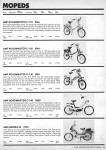
Buyers Guide p45
AMF Roadmaster 110
AMF Roadmaster 120
AMF Roadmaster 130
AMF Roadmaster 140
AMS Sierra 50
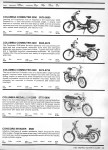
Buyers Guide p49
Colombia Commuter
Colombia Commuter
Colombia Commuter
Colombia Medallion
Concord Invader

Buyers Guide p52
Dialex EZ Rider
Garelli Sport
Garelli Rally Sport
Garelli Rally Sport Ltd
Garelli Super Sport XL
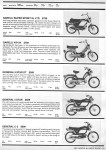
Buyers Guide p53
Garelli Super Sport Ltd
Garelli VIP 2-Speed
General 5 Star ST
General 5 Star
General C-2
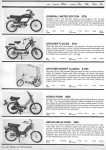
Buyers Guide p54
General Limited Edition
Grycner Floozie
Grycner Desert Classic
Honda PA50II Hobbit
Indian AMI-50 Chief
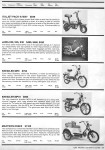
Buyers Guide p55
Italjet Pack-A-Way
Jawa X20, X25, X30
Kreidler Flory MP9
Kreidler Flory MP19
Maxtron Essex
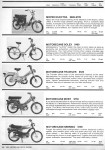
Buyers Guide p56
Moprix Electra
Motobecane Solex
Motobecane Traveler
Motobecane Moby
Motobecane Sebring
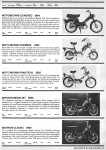
Buyers Guide p57
Motobecane Le Moped
F. Morini Chembol
F. Morini Pratikal
Motron Medallist
Motron Classic
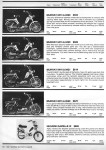
Buyers Guide p58
Murray 8315, 8320
Murray 8415, 8420
Murray 8416, 8421
Murray 8515, 8520
Negrini Gazelle III
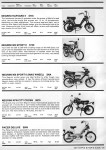
Buyers Guide p59
Negrini Harvard II
Negrini MX Sport II
Negrini MX Sp. II mag
Negrini KPN City Cross
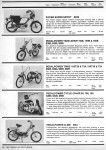
Buyers Guide p60
Pacer Super Sport
Pedalpower TakeApart
Pedalpower Trike
Pedalpower Chair
Pedalpower G200
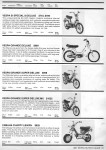
Buyers Guide p67
Vespa Si Deluxe, Super
Vespa Grande Deluxe
Vespa Grande Super
Vespa Grande Sup. MX
Yamaha Chappy LB50
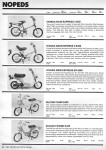
Buyers Guide p68
Honda NC50 Express
Honda NA50 Express II
Honda NX50 Express SR
Suzuki FA50 Shuttle
Suzuki FA50M 20mph
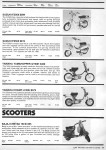
Buyers Guide p69
Suzuki FZ50 Rascal
Suzuki FS50
Yamaha Yamahopper
Yamaha LC50 Champ
Bajaj Chetak 150
Pinned or Not Pinned: Most moped piston rings are two-stroke style, where there are pins in the ring grooves of the piston that keep the rings from rotating around. Two stroke cylinders have holes or ports that the ring ends can snag on. So two stroke rings are pinned to the piston. Four stroke cylinders do not have any holes, so four stroke rings are not pinned. Knowing about those pins is important when installing.
Getting the right rings: If your model is not in the applications, then you must measure the bore and the ring thickness. A calipers is the best tool to measure the bore (ring diameter) and ring thickness. Sometimes your rings might not be original, for many reasons. The piston might be aftermarket with thinner rings. The cylinder might be bored out to an oversize bore. Some mopeds came with more than one piston size or ring style.
Break a ring, how not to: Two stroke pistons have little pins (stumps, bumps) in the piston ring grooves that prevent the rings from rotating. Knowing where each ring locating pin is, and aligning the ring gap over the pin during cylinder installation, is the key to not breaking the ring.
If the piston is used the ring grooves will need to be cleaned (scraped). Use a piece of old broken ring as a scraper. Make sure the installed ring can rotate freely completely around and close fully in the ring groove.
Then make sure the bare piston will enter the cylinder. Then place each ring in the cylinder to make sure the gap is right, a tiny slit. Once both the piston and rings separately fit the cylinder, then proceed to install everything at once.
Use both thumbnails to spread the ring just enough. Place the ring gap over the ring gap pin. As the piston enters the bottom of the cylinder the slanted cut and the bottom of the cylinder begins to close the top ring. Look at the gap to make sure it is over the locating pin. Wiggle the piston slightly and push gently until the tom ring enters the cylinder and closes fully. Then repeat with the bottom ring.
Replacing Rings
Measuring wear: A new piston ring is a the best tool to measure how worn a cylinder is. Conversely, a new cylinder is the best tool to measure how worn a ring is. To measure the wear of a ring, you need a perfectly round cylinder of a precisely known bore. A worn cylinder that has not been honed will still have it’s original new bore at the very top, above where the rings rub at. A new ring in a new cylinder should have a very small end gap of .004 to .008″. A worn but still OK cylinder with a new ring will have a gap of .0010 to .018″. A worn cylinder and ring both will have an end gap of over .020″(.5mm). A badly worn cylinder and/or ring will have a huge gap, over .030″(.75mm). You measure ring gap with a feeler gauge.
Classifying rings: Rings get mixed up and are difficult to tell the size, unless a perfectly round cylinder of an appropriate size is available to place the ring in. If you try to squeeze a piston ring into a circle with just fingers, it inevitably becomes a very rounded polygon, or at best an ellipse. So the measurement becomes inaccurate. At right is how Myrons Mopeds’s Jawa piston rings were classified, using a piece of aluminum tubing with a tight fitting piston inside it to hold the tube round, and the test ring square. From top to bottom, 39.03 x 2.0, 39.28 x 2.0, 39.53 x 2.0, 39.78 x 2.0mm. Each ring increases in diameter by 0.25mm, so the circumference increases by Pi times that, or about 0.8mm. Here the inside of an old fishing pole tube is 39.78mm, perfect for the 3rd oversize 39.78 ring, on the bottom, with a gap of almost zero. Each gap is 0.8mm more because each ring is 0.25mm less diameter. It is important that the piston and ring fit the cylinder properly.
Filing down: To make a ring slightly smaller, one of the two ring ends can be filed down, while preserving the shape. To reduce the size (diameter) by 0.20 mm, the end must be filed down by pi times that, 0.63 mm. When a filed down ring is installed in a cylinder smaller than it was designed for, two things change. The tension is greater, and the shape is slightly non-circular. So filed rings need a longer break-in period, to wear down the higher places. With 38 to 41 mm rings, the size can be reduced by 0.2mm with about 30 minutes of break-in, and by 0.5mm with about 2 hours of break-in. After break-in the rings have a mirror polish all around.
Why is the width not specified? Because the inner side of the ring does not touch anything. The ring has spring tension pushing it outwards, keeping the bottom (inner) surface from touching the bottom of the ring groove. So the ring width can be any amount, from about half the groove depth, to the groove depth. The exact ring width is not important. Exact ring height and diameter are important.
Two-stroke Piston Installation: Unlike a four-stroke engine, a two-stroke has holes in the cylinder wall, called ports. The ends of the rings are prevented from passing over any of the ports, by pins in the piston, inside or alongside the ring groove. A four-stroke piston does not have ring pins. Two-stroke ring pins often get overlooked, resulting in broken or damaged rings. See above about ring installation.
Pistons can be installed backward. Some do not matter which side faces forward or backward. But most do have a intake side (usually rear or up facing) and an exhaust side (usually forward or down facing). If it matters which way there will be a mark on the top of the piston, usually an arrow, on the exhaust side. Some Italian pistons say “SC” on the exhaust (scoria) side instead of an arrow.
There is a way to tell which way a piston faces regardless of the markings. This method is for when arrow on top is missing, or gets coated with black carbon, or if the piston is a substitute made for a different engine or cylinder. Remove the cylinder and piston and rings. Mark the top of the piston where the ring pins are. Place the piston in the cylinder at the bottom of the stroke, where the piston top is even with the exhaust port bottom. The angle of the piston pin needs to be the same as if it was on the crank. Now look straight up the cylinder wall from the ring pin marks for any ports. The ring gaps should never be closer that about 3mm 1/8″ from any port. If they they are then rotate the piston 180 degrees and see if that way works. If any ring end is allowed to pass over a hole, the engine will run for awhile, maybe 5 minutes to an hour. Then the ends of the ring will become rounded and the engine will loose compression.
Piston to cylinder clearance: It’s important that the piston fits the cylinder properly. An old messed up piston that fits correctly is better than a new piston that fits too loose or too tight. Too loose will be hard to start and weak. Too tight will seize up when hot. Often a cylinder needs to be bored out slightly to fit an oversize piston. Some aluminum cylinders have plated walls that cannot be bored out. The piston diameter, measured at the skirt, is a hair smaller than the cylinder bore.
The following piston/cylinder clearance limits are from the Puch factory service manual:
Puch “Lo-torque” nikasil plated aluminum (7-fin) cylinders: Min .0008“(.020mm) Max .0016“(.040mm)
Puch “Hi-torque” steel sleeved aluminum (8-fin) cylinders: Min .001″ (.029mm) Max .002“(.055mm)
Puch “Magnum” steel sleeved aluminum (9-fin) cylinders: Min .001″ (.029mm) Max .002“(.055mm)
As the engine gets hot, the piston to cylinder clearance approaches zero. Besides “diam“, “upper“, “pin“, and “lower“, other things matter in piston compatibility. The ring pins must locate the ring gaps so they never pass over a port. The exhaust-side skirt must be long enough to cover the exhaust port at tdc. The intake-side skirt, on a piston port two stroke, controls the intake timing. Shorter skirt opens sooner and closes later. A longer intake skirt is one way some mopeds are restricted in power. Simply grind the excessively long piston skirt back to 30mph specification, but no farther, to de-restrict the piston. Puch, Tomos, Garelli are the main kinds that use longer pistons to lower the speed, for 25 and 20mph states or jurisdictions. This list contains all pistons made by original equipment manufacturers, although most of them are no longer available. The not-available ones are listed for their information, such as speed versions or piston size choices. If you happen to have an unknown piston with or without a part number, you can identify what it is from this list by measuring it and looking for matching measurements. From all these specifications, perhaps a compatible piston can be found or adapted.
Honing: There are two kinds of hones, solid and flexible, with different purposes.
1) A solid type adjustable flat-stone hone will shave off high spots and restore roundness. It is used first for when there is damage like melted aluminum stuck to the cylinder wall, or gouges, or just regular wear at mostly the top exhaust side. After a dozen rotations or so any high spots are revealed, because the stone does not touch the low spots or worn areas. This type of hone is useful for both diagnosing and restoring.
2) A flexible flat-stone or ball-stone will skip over high spots and not restore roundness. It is used last for lightly scratching the cylinder wall surface, and for rounding any sharp edges on the ports. Simple “finger sanding” with emery cloth is almost the same as flexible-ball honing.
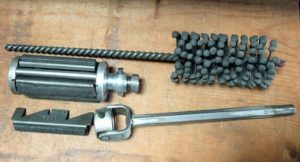
Top is a flexible hone, ball type, 2″ (when new).
Bottom is a solid hone, adjustable, 1½-2″.
One of the flat stones is shown removed.

A worn Benelli G2 cylinder after solid-type honing.
Light areas are shaved. Dark (worn) areas are untouched.
Max wear zone is near the top where the pressure is most.
The very top does not wear because the rings don’t rub there.
Cylinder checking and honing:
1) Before honing, the used top ring is placed at the very top of the cylinder, where no wear occurs. The ring gap is noted, either visually or measured with a feeler gauge. If the cylinder has never been honed before, the ring gap at very top will indicate how much ring wear there is.
2) If a new ring is available, place it at the top and notice the ring gap. If the cylinder has never been honed it will have a very small gap, 0.004 – 0.008 inch (0.1 to 0.2 mm). That is only a little more than one human hair! Now place the ring in the maximum wear zone at the top of the ring travel. Compare the ring gap there. That tells how much wear the cylinder has since it was either new or last honed.
3) With just the ring installed squarely in the max wear zone, hold the cylinder towards a white wall or brightly lit background. Visually see if any light can get under the ring. This checks both the ring and cylinder for roundness. If the ring is new and is the correct size, this checks the cylinder for roundness.
4) The cylinder is honed briefly with a solid-type adjustable hone (not flexible). This shaves off high spots and exposes worn areas.
5) It is visually inspected for any deep grooves remaining, especially higher than the top of the exhaust port. If grooves and low areas remain, honing is repeated until most of the high areas are shaved off and only some low areas or shallow grooves remain.
6) Solid-honing restores the condition of the cylinder wall, which is a good thing. But it also makes the cylinder bigger, which is a bad thing. The least amount of honing is best. So leave some patches of un-honed cylinder wall, like in the Benelli cylinder example shown above. When the engine first runs with new rings, the final polishing will occur.
7) After solid-type honing, use a flexible ball type hone to lightly scratch the entire surface, and to round off sharp edges of the ports. The hone is pulled and pushed in and out while rotating, to make a cross hatch pattern. The diagonal scratches help oil to get under the entire ring during break-in. This helps the new rings and cylinder wall to become polished like a mirror after the first few dozen miles of running.
Piston pin hole checking and Piston pin bushing reaming
On most 1960’s and 70’s small two-stroke engines, the piston swings on a bushing. Only some had needle bearings. By the 1990’s all small engines had needle bearings. A needle bearing can endure running without oil, but a bushing cannot. Upgrading to a needle bearing is a good thing, but it is often not possible with the same crank rod. Usually the rod hole needs to be bigger. With Puch, the 12 x 14 bushing has no needle bearing equivalent. The nearest needle bearing size is 12 x 15 (with 1.5 mm rollers). A 12 x 14 bearing would need 1.0 mm rollers, too thin and long to resist bending or breaking. So in most cases it is necessary to re-use or replace the bushing. Below is the procedure for checking, replacing, and reaming the piston pin bushing.